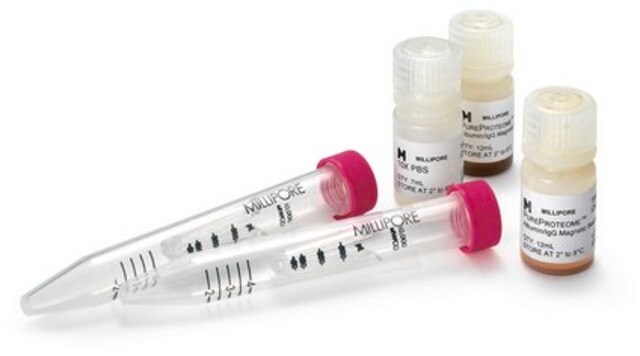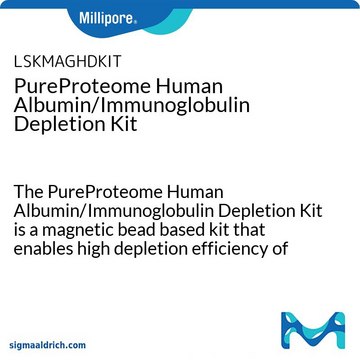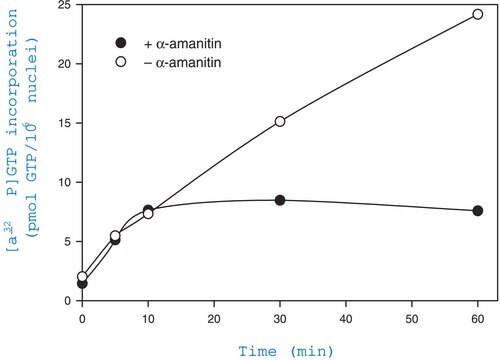122643
ProteoExtract® Albumin/IgG Removal Kit, Maxi
Faça loginpara ver os preços organizacionais e de contrato
About This Item
Código UNSPSC:
41106500
Produtos recomendados
uso
sufficient for 10 sample(s) (IgG-containing; 60-180 μl each)
sufficient for 20 sample(s) (Albumin-containing; 60-180 μl each)
fabricante/nome comercial
Calbiochem®
condição de armazenamento
do not freeze
protect from light
entrada
sample type serum
sample type plasma
sample type cerebrospinal fluid (CSF)
Condições de expedição
wet ice
temperatura de armazenamento
2-8°C
Categorias relacionadas
Descrição geral
High capacity, reusable columns specifically designed for the rapid and efficient removal of >80% of albumin (column 1 containing albumin-affinity resin) and IgG (column 2 containing immobilized protein A) from body fluid samples, either on an LC-instrument or manually, attached to a syringe. Removal of these high abundance proteins allows enhanced detection of low abundance proteins.
Componentes
Two Albumin Removal Columns, one IgG Removal Column, 10X Albumin/IgG Binding Buffer, Albumin Elution Buffer, IgG Elution Buffer, and a user protocol.
Advertência
Toxicity: Multiple Toxicity Values, refer to MSDS (O)
Princípio
The ProteoExtract Albumin/IgG Removal Kit, Maxi provides a convenient, reproducible and highly specific method to remove serum albumin and immunoglobulins from body fluid samples. The kit provides columns containing either a novel albumin-specific affinity resin or a proprietary immobilized protein A polymeric resin. These columns allow for the removal of more than 80% of both serum albumin and immunoglobulins from human body fluid samples when used according to the instructions provided in this manual. The column hardware is designed to allow for both manual and LC-instrument controlled usage. When used manually, the columns are operated as syringe-tip filters, when used with LC-instrument control, the columns can be connected to any standard HPLC/FPLC instrument via a 10/32" port using the provided adapters. For guidelines of column connections and operation, please refer to section 3 of this manual.
Nota de preparo
The albumin removal column contains a resin that has been optimized for the removal of albumin from human samples. However, the provided columns will also bind albumins from other species although with lower efficiency. The dynamic binding capacity of one column was determined to be 6.1 ± 0.3 mg human albumin in Binding Buffer at a flow rate of 0.1 ml/min and 10 % breakthrough. To provide guidelines for different species we have evaluated the relative amount of albumin bound to the albumin removal column (Table 2).<div class="Bio_doc_image">
Table 2: Albumin Removal Column
</div>The Binding Buffer provided with the kit has been optimized to allow for specific binding of both albumin and immunoglobulins to the respective column without requirement of buffer exchange. This allows for the subsequent use of the two types of columns either independently using the flow through of the albumin removal column as sample load for the IgG removal column or with the two types of columns being directly connected in a row.The IgG Removal Column contains Protein A which is a highly stable surface receptor produced by Staphylococcus aureus. Protein A binds the Fc portion of IgGs from a large number of species. The dynamic binding capacity of the Protein A column was determined to be 4.5 mg ± 0.2 mg human IgG in Binding Buffer at a flow rate of 0.1 ml/min and 10 % breakthrough. The provided removal columns are guaranteed to be functional as indicated when bound proteins are eluted with the provided removal buffers and columns are used according to the manufacturers instructions given in this manual.
Table 2: Albumin Removal Column
</div>The Binding Buffer provided with the kit has been optimized to allow for specific binding of both albumin and immunoglobulins to the respective column without requirement of buffer exchange. This allows for the subsequent use of the two types of columns either independently using the flow through of the albumin removal column as sample load for the IgG removal column or with the two types of columns being directly connected in a row.The IgG Removal Column contains Protein A which is a highly stable surface receptor produced by Staphylococcus aureus. Protein A binds the Fc portion of IgGs from a large number of species. The dynamic binding capacity of the Protein A column was determined to be 4.5 mg ± 0.2 mg human IgG in Binding Buffer at a flow rate of 0.1 ml/min and 10 % breakthrough. The provided removal columns are guaranteed to be functional as indicated when bound proteins are eluted with the provided removal buffers and columns are used according to the manufacturers instructions given in this manual.
Armazenamento e estabilidade
Upon arrival store entire contents of the kit at 4°C. Avoid freezing of the ProteoExtract Blue and ProteoExtract Protein A columns! Freezing thawing will destroy the affinity resin and the columns no longer function.
Outras notas
Boyle, M. D. P. and K. J. Reis., 1987. Biotechnology5, 697.
Due to the nature of the Hazardous Materials in this shipment, additional shipping charges may be applied to your order. Certain sizes may be exempt from the additional hazardous materials shipping charges. Please contact your local sales office for more information regarding these charges.
Informações legais
CALBIOCHEM is a registered trademark of Merck KGaA, Darmstadt, Germany
PROTEOEXTRACT is a registered trademark of Merck KGaA, Darmstadt, Germany
Código de classe de armazenamento
11 - Combustible Solids
Certificados de análise (COA)
Busque Certificados de análise (COA) digitando o Número do Lote do produto. Os números de lote e remessa podem ser encontrados no rótulo de um produto após a palavra “Lot” ou “Batch”.
Já possui este produto?
Encontre a documentação dos produtos que você adquiriu recentemente na biblioteca de documentos.
Pengchong Li et al.
Nature immunology, 22(9), 1107-1117 (2021-08-14)
The linkage between neutrophil death and the development of autoimmunity has not been thoroughly explored. Here, we show that neutrophils from either lupus-prone mice or patients with systemic lupus erythematosus (SLE) undergo ferroptosis. Mechanistically, autoantibodies and interferon-α present in the
Nossa equipe de cientistas tem experiência em todas as áreas de pesquisa, incluindo Life Sciences, ciência de materiais, síntese química, cromatografia, química analítica e muitas outras.
Entre em contato com a assistência técnica







